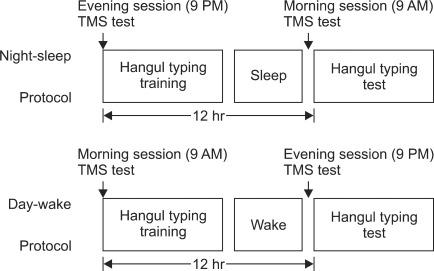Ann Rehabil Med.
2012 Apr;36(2):226-232. 10.5535/arm.2012.36.2.226.
Effects of Night Sleep on Motor Learning Using Transcranial Magnetic Stimulation
- Affiliations
-
- 1Department of Rehabilitation Medicine, Inha University College of Medicine, Incheon 400-711, Korea. rmjung@inha.ac.kr
- KMID: 2266761
- DOI: http://doi.org/10.5535/arm.2012.36.2.226
Abstract
OBJECTIVE
To investigate the effects of night sleep on motor cortical excitability with TMS (transcranial magnetic stimulation) and finger tapping performance. METHOD: Eight volunteers were enrolled to investigate the effects of day wake or night sleep on motor learning and finger performance. Each subject underwent a finger tapping task over a 12 hour period, which was employed to evaluate the motor cortical excitability affected by motor learning. Starting at 9:00 am for the day wake cycle and restarting at 9:00 pm for the night sleep cycle. The finger tapping task was the index finger of the non-dominant hand with the Hangul word personal computer (PC) training program. The data was assessed by comparing the changes observed with the cortical excitability and finger tapping performance tests between the day wake and night sleep after equivalent amounts of training.
RESULTS
The results showed that in paired-pulse techniques, there was a significant decrease of intracortical inhibition (ICI) in the morning following the night sleep cycle (p<0.05), but no significant change was seen in the ICI in the evening for the day wake cycle. In addition a significant decrease of the ICI was observed in comparison to the morning following the night sleep cycle and the evening following the day wake cycle (p<0.05). The 140% recruitment curve (RC) and accuracy of the finger tapping performance demonstrated a significant improvement for both cycles (p<0.05).
CONCLUSION
Through this study, we observed that the Hangul typing practice requires both explicit and implicit skill learning. And also the off-line learning during a night of sleep may be affected by an inhibitory neurotransmitter related synaptic plasticity and by the time dependent learning with recruitments of remote or less excitable motor neurons in the primary motor cortex.
Keyword
MeSH Terms
Figure
Reference
-
1. Robertson EM, Press DZ, Pascual-Leone A. Off-line learning and the primary motor cortex. J Neurosci. 2005; 25:6372–6378. PMID: 16000627.
Article2. Robertson EM, Pascual-Leone A, Miall RC. Current concepts in procedural consolidation. Nat Rev Neurosci. 2004; 5:576–582. PMID: 15208699.
Article3. Robertson EM, Pascual-Leone A, Press DZ. Awareness modifies the skill-learning benefits of sleep. Curr Biol. 2004; 14:208–212. PMID: 14761652.
Article4. Diekelmann S, Born J. The memory function of sleep. Nat Rev Neurosci. 2010; 11:114–126. PMID: 20046194.
Article5. Walker MP, Stickgold R, Alsop D, Gaab N, Schlaug G. Sleep-dependent motor memory plasticity in the human brain. Neuroscience. 2005; 133:911–917. PMID: 15964485.
Article6. Robertson EM. The serial reaction time task: implicit motor skill learning? J Neurosci. 2007; 27:10073–10075. PMID: 17881512.
Article7. Devanne H, Lavoie BA, Capaday C. Input-output properties and gain changes in the human corticospinal pathway. Exp Brain Res. 1997; 114:329–338. PMID: 9166922.
Article8. Ziemann U, Rothwell JC, Ridding MC. Interaction between intracortical inhibition and facilitation in human motor cortex. J Physiol. 1996; 496:873–881. PMID: 8930851.
Article9. Kujirai T, Caramia MD, Rothwell JC, Day BL, Thompson PD, Ferert A, Wroe S, Asselman P, Marsden CD. Corticocortical inhibition in human motor cortex. J Physiol. 1993; 471:501–519. PMID: 8120818.
Article10. Steriade M, Timofeev I. Neuronal plasticity in thalamocortical networks during sleep and waking oscillations. Neuron. 2003; 37:563–576. PMID: 12597855.
Article11. Walker MP, Brakefield T, Morgan A, Hobson JA, Stickgold R. Practice with sleep makes perfect: sleep-dependent motor skill learning. Neuron. 2002; 35:205–211. PMID: 12123620.12. Karni A, Meyer G, Jezzard P, Adams MM, Turner R, Ungerleider LG. Functional MRI evidence for adult motor cortex plasticity during motor skill learning. Nature. 1995; 37:155–158. PMID: 7675082.
Article13. Perez MA, Lungholt BK, Nyborg K, Nielsen JB. Motor skill training induces changes in the excitability of the leg cortical area in healthy humans. Exp Brain Res. 2004; 159:197–205. PMID: 15549279.
Article14. Dudai Y. The neurobiology of consolidations, or, how stable is the engram? Annu Rev Psychol. 2004; 55:51–86. PMID: 14744210.
Article15. Smith C. Sleep states and memory processes in humans: procedural versus declarative memory systems. Sleep Med Rev. 2001; 5:491–506. PMID: 12531156.
Article16. Hallett M. Transcranial magnetic stimulation: a useful tool for clinical neurophysiology. Ann Neurol. 1996; 40:344–345. PMID: 8797523.
Article17. Ziemann U, Lonnecker S, Steinhoff BJ, Paulus W. Effects of antiepileptic drugs on motor cortex excitability in humans: a transcranial magnetic stimulation study. Ann Neurol. 1996; 40:367–378. PMID: 8797526.
Article18. Liepert J, Schwenkreis P, Tegenthoff M, Malin JP. The glutamate antagonist riluzole suppresses intracortical facilitation. J Neural Transm. 1997; 104:1207–1214. PMID: 9503266.
Article19. Ridding MC, Rothwell JC. Stimulus/response curves as a method of measuring motor cortical excitability in man. Electroencephalogr Clin Neurophysiol. 1997; 105:340–344. PMID: 9362997.
Article
- Full Text Links
- Actions
-
Cited
- CITED
-
- Close
- Share
- Similar articles
-
- Motor Evoked Potentials in Masseter, and Anterior Belly of Digastric Induced by Transcranial Magnetic Stimulation
- Enhancing Motor Learning with Transcranial Direct Current Stimulation
- Application of Non-invasive Brain Stimulation for Neurorehabilitation: Cerebellar Stimulation
- Neuromodulation for Insomnia Management
- Effect of Non-Invasive Brain Stimulation on Sleep and Sleep Disorders






